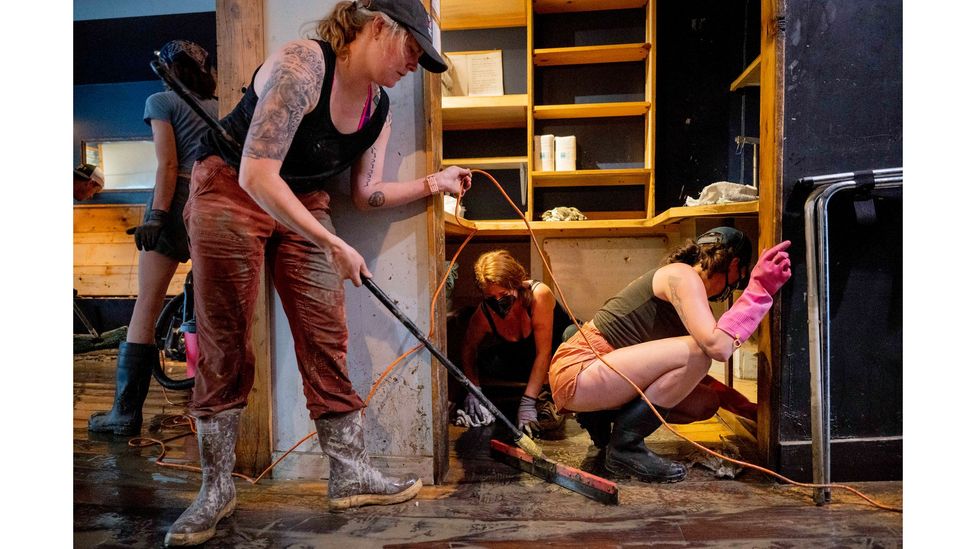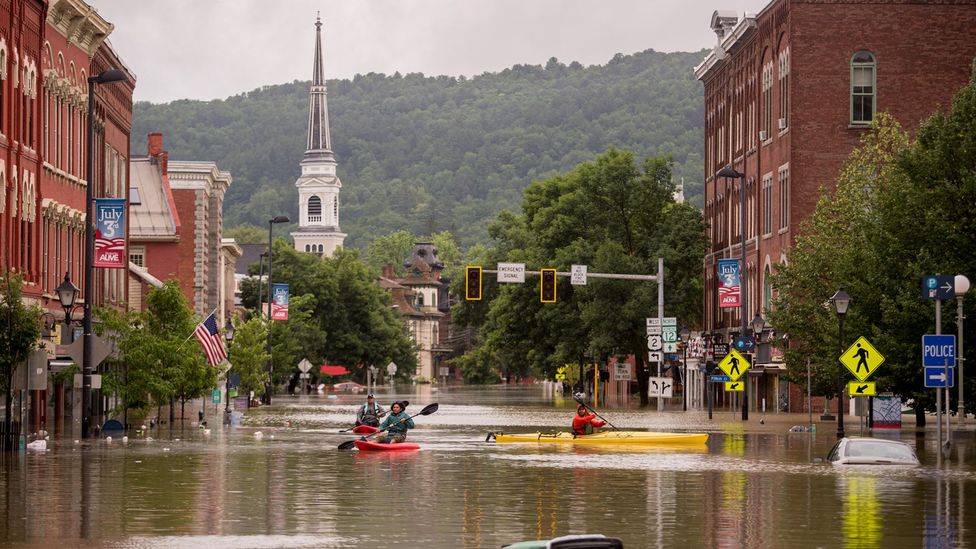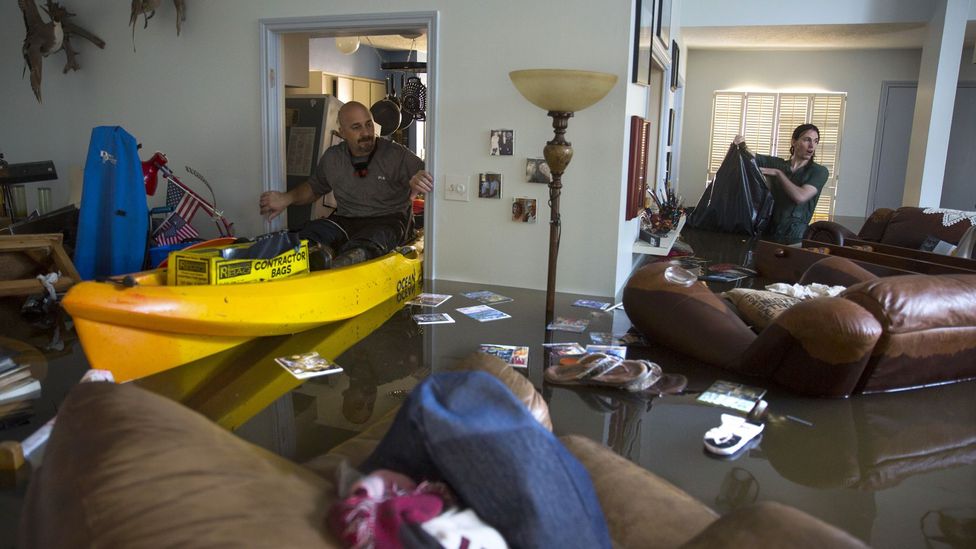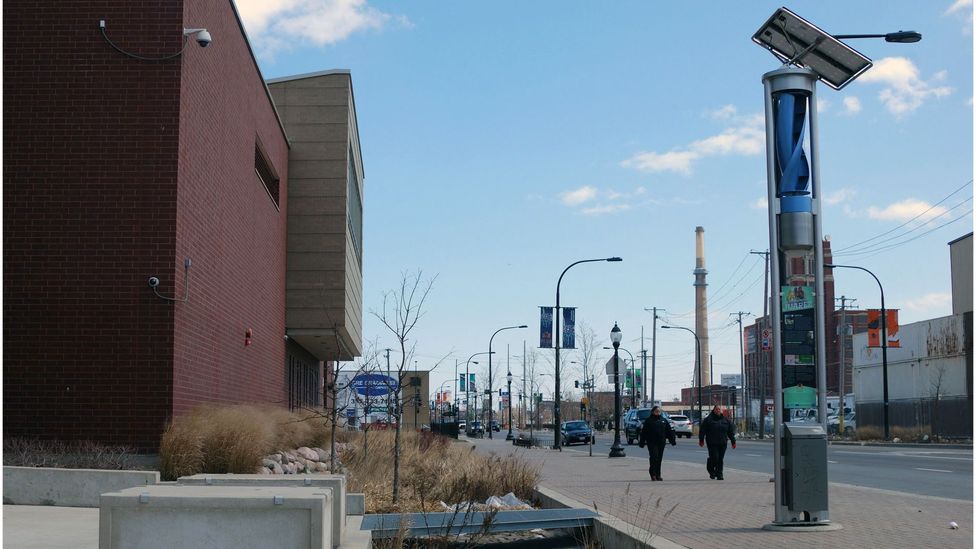A black and red kayak sits propped up outside Tygart Mountain Sports in Ludlow, Vermont, strapped to the pillar as an invitation for passers-by to enter the ski and mountaineering store.
Moments later, a security camera shows a wave of dirty brown water flooding through the street, crashing up against the kayak. It drags shopping trolleys, rubbish bins and other debris along with it, turning the quiet street into a rushing river.
Alarmingly, the residents of Ludlow, usually a ski resort town, would soon be using kayaks to paddle down roads submerged under 3.5ft (1.1m) of water.
In early July, the state of Vermont was hit by historic flooding, which caused at least one death and battered roads, bridges and homes. There were more than 9in (22cm) of rain in a single day in some areas of the state, after storms dumped up to two months of water in a matter of days. The flooding reached such devastating levels that US President Joe Biden declared a state of emergency, after the Winooski River burst its banks and the Wrightsville Dam neared capacity – which would have caused unprecedented damage if the dam had failed.
Identifying key floodplains has already begun in Vermont
Storms like these were once known as 100-year events. Now, due to climate change, they're happening more frequently. One recent study projected that the Northeastern US would see a 52% rise in extreme precipitation by the end of this century. Another study found property damage from flooding in Vermont will likely exceed $5.2bn (£4bn) over the next 100 years – over double the damage expected in a scenario without climate change.
What's more, it's low-income households that will be hit the hardest. "Climate change-fuelled impacts are hitting communities that don't have the resources – and they are going to be left behind," says Shana Udvardy, senior climate resilience policy analyst at the Union of Concerned Scientists, a non-profit science advocacy organisation.
"Low income, historically disadvantaged communities are hit first and worst. We really need to pay attention to that."

Clara Walsh, Rachel Farrell and Erika McCormick help clean up Three Penny Taproom in Montpelier, Vermont, after damage due to major flooding in July 2023 (Credit: Getty Images)
Cutting global emissions is crucial to avoid the worst impacts of climate change, but some of these impacts are already locked in – and already being felt by communities across the world, including many in the US.
Research has shown that urban planning can help to mitigate many of these impacts, such as by better designing communities and urban environments to anticipate and respond to natural events. In Vermont, this is already underway – with a focus on increasing resilience to flooding.
One key focus is on restoring natural habitats that act as flood barriers. As climate change brings more frequent and severe storms, the value of natural assets such as floodplains and wetlands will only increase, according to Taylor Ricketts, director of the University of Vermont's Gund Institute for Environment.
A 2022 article from researchers at the University of Vermont found that restoring key floodplains in Vermont could reduce flood-related damages by 20%, due to their absorption of water, which reduces the amount and speed of water that reaches communities.
There are a number of ways to restore these floodplains, from reshaping riverbanks and restoring wetlands to adding vegetation. "We need to think about floodplains as green infrastructure," Ricketts says.
You might also like:
- Italy's plan to save Venice from sinking
- The UK 'climate refugees' who won't leave
- The nation learning to embrace flooding
Identifying these key floodplains has already begun in Vermont. In 2008, a large-scale restoration project was completed in the north of the state, reconnecting more than 200 acres (81 hectares) of historic floodplain.
The scheme was made possible by the willingness of local landowners to work with the Vermont Agency of Natural Resources to naturalise flooding on their land, according to a report on the project a year later. Local flood and erosion risks had already been reduced by the floodplain reconnection, it added, while observable sediment deposit was now taking place – a crucial factor in preventing soil erosion.
The state has also been purchasing flood-prone properties as part of a programme to get homeowners to higher ground, after the Federal Emergency Management Agency provided Vermont $20m (£15.5m) for voluntary buyouts. To date, 149 homes have been bought and demolished.
However, residents report mixed feelings on the scheme, with some concerned about where they will go and that the full costs of moving are not covered, especially for people living in mobile homes. Others are worried about falling house prices following buyouts, unfair valuations on their homes, and the loss of communities. Buyouts are lengthy processes, which can make them less accessible, less equitable to low-income households, and less effective. Despite these concerns, there's still a waiting list across the US for buyouts.

Montpelier was among several cities in Vermont hit by flooding in July 2023. Research shows better urban planning can help reduce impacts from flooding (Credit: Getty Images)
Vermont isn't the only state that's been funnelling funding into measures to reduce flooding.
In Texas in early July, while residents were already grappling with extreme, deadly heatwaves, severe storms dumped heavy rain in the state's northern panhandle. A month earlier, flash flooding had devastated homes and led its governor to issue a disaster declaration.
Of course, flooding is nothing new in Texas: in 2017, the state was decimated by Hurricane Harvey, which caused $125bn (£97bn) in damage, completely destroying more than 15,500 homes.
In the hurricane's wake, Texas lawmakers launched a state-wide flood plan to assess vulnerability to flooding, and understand which projects could prevent damage. The plan estimated more than $38bn (£29bn) would be needed just to get started on flood prevention across the state – a figure that experts say is "vastly understated".
In 2022, the US House approved a separate bill for a $31bn (£24bn) coastal barrier project that federal agencies hope will protect hundreds of miles of Texas coastline The project would include a two mile (3.2km) -long concrete gate nicknamed the "Ike Dike" – after Hurricane Ike – as well as artificial barriers and beach and dune restoration.
However, even if the project is given the go-ahead by the US Senate, nobody quite knows how it will be funded.
One project that is going ahead, though, is a 11,400-acre (4,600-hectare) housing development named Bridgeland northwest of Houston, Texas. Its developers decided to build a resilient community for 65,000 residents from scratch.
Bridgeland is just one example of climate-resilient master-planned communities popping up around the US in places where extreme weather is becoming ever-more common – Stefani Danes
Bridgeland's stormwater system, designed to accommodate a 100-year storm, is a key part of this. Houses are positioned near lakes and open spaces with the capacity to take on flood water. Overflow channels also crisscross the site, while pedestrian underpasses double up as stormwater conveyance channels – preventing erosion and carrying stormwater runoff.
The system has already been tested by two historic flood events: the Tax Day flood in 2016, where a storm dumped 24in (61cm) of rain in 24 hours, and Hurricane Harvey a year later, when more than 50in (127cm) of rain fell. In both events, tens of thousands of homes flooded across the Houston area. A series of lakes with sloping banks that can hold excess rains were built at Bridgeland, two feet (61cm) deeper than what county regulations required. Not a single home flooded during either event, in stark comparison with nearby neighbourhoods.
It's just one example of climate-resilient master-planned communities popping up around the country in places where extreme weather is becoming ever-more common, says Stefani Danes, an architect and urban designer at Carnegie Mellon University. Danes is developing the Rachel Carson EcoVillage in Pittsburgh, a 35-unit community designed to "connect humans with nature".
"There's so much more awareness of how inextricably linked we are to our natural surroundings," she says of the increase in developments that are putting climate adaptation as a priority. "If we want things to last, whether they're towns by the rivers or even our own houses, we have to understand how nature works and do our best to work with that."

Larry Koser Jr looks with his son for papers and heirlooms in Houston, Texas after his house was flooded by heavy rains from Hurricane Harvey in August 2017 (Credit: Getty Images)
Many cities, of course, do not have the option to begin their urban planning completely afresh. But many are still exploring ways to better protect residents from flooding.
In Chicago, which is projected to see 20% more rainfall overall by 2099, significant investment has been put into stormwater management over the past decade.
Permeable pavements are one tactic being pursued. Pavements are a major contributor to why urban areas flood so dramatically; water cannot be absorbed by the impervious surfaces and in highly urbanised areas, more than half of all rain becomes surface runoff.
Chicago's "green alleys" allow stormwater to filter through and drain into the ground, lessening runoff during storms. Between 2001 and 2017, more than 300 green alleys have been installed, with more being rolled out across the city.
Officials say if all of Chicago's 1,900 miles (3,050km) of public alleys were transformed to green alleys, 80% of the rainwater falling on those surfaces would pass back into the earth, reducing flooding, recharging groundwater and saving taxpayer money that would be spent treating stormwater. (Read about the other cities trying to increase their "sponginess").
Despite the new initiative, though, residents were still wading through water when their upgraded street flooded following heavy rainfall in 2021.
Rain gardens and green roofs are other fairly straightforward methods that can have a huge impact on slowing the flow of water and cleaning it of pollutants.
Chicago has also poured $14m (£11m) into building the "greenest street in America", a two mile (3.2km) long street in the city's lower west side. The street includes landscaped shallow troughs known as bioswales, which act as environmentally-friendly drainage, filtering and absorbing polluted water, and redirecting it to either feed surrounding plants, or end up back in Lake Michigan.
"It's very simple, but it's very difficult for people to grasp, because we've not designed like that in a century," says Jay Womack, a senior landscape architect at Huff & Huff, which was commissioned by the city to design the street. Around 80% of rainfall is diverted from the sewage system, and the road no longer floods, according to Womack.
Rain gardens and green roofs are other fairly straightforward methods that can have a huge impact on slowing the flow of water and cleaning it of pollutants, as well as helping to recharge groundwater in a way that mimics the natural environment.
In Portland, Oregon, rain gardens have helped save the city $63m (£49m) in pipe replacement, as they infiltrate almost one million gallons (4.5 million litres) of stormwater every year that would otherwise enter sewer pipes. The city has partnered with residents and businesses to roll out these gardens.

A wind and solar generator powers streetlights and a pond to divert storm water from sewers on 'the greenest street in America', in Chicago in 2013 (Credit: Getty Images)
Studies have shown that urban design has the power to help protect vulnerable communities in particular against climate change. Low income and ethnic minority communities often have the least resources to protect against and recover from extreme weather, but building climate resilient infrastructure in their neighbourhoods can help tackle this environmental inequity. Green streets also help reduce the urban heat island effect, which particularly impacts these populations.
However, there is still a long way to go before this inequity is addressed in a more systemic way, says Udvardy.
"There's not one agency that's responsible for specific resilient measures and so we're seeing a piecemeal approach," she says. "What's lacking is the one comprehensive plan to help really prioritise federal funding towards vulnerable communities that are being hit first and worse."
Carbon Count
The emissions from travel it took to report this story were 0kg CO2. The digital emissions from this story are an estimated 1.2g to 3.6g CO2 per page view. Find out more about how we calculated this figure here.
A country-wide approach to tackling flooding is needed, says Udvardy, and all levels of government need to play a part in preparing communities for climate impacts.
Her focus is on highlighting "dangerous season" to policymakers – the six-month stretch between May and October when climate change-fuelled extreme weather events are at their most intense. Udvardy believes that it's even more crucial to ensure vulnerable communities are protected and have access to federal support during this period.
Danes adds that more policies are needed to start encouraging more ecologically resilient ways of living and building. "We need to understand there are certain places that it's never going to be a good idea to live in, and floodplains is one type of place where we shouldn't be building back," she says. "We [mistakenly] think it's heroic to live in those places."
This means those who have lost property deserve assistance to pick up their lives in a safer place, she adds. "That's better for them. It's better for society. Nature is sending us a very clear message."
--
Join one million Future fans by liking us on Facebook, or follow us on Twitter or Instagram.
If you liked this story, sign up for the weekly bbc.com features newsletter, called "The Essential List" – a handpicked selection of stories from BBC Future, Culture, Worklife, Travel and Reel delivered to your inbox every Friday.